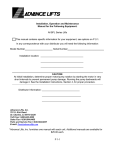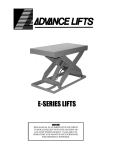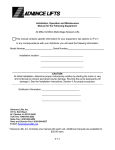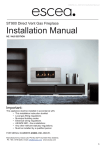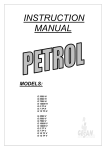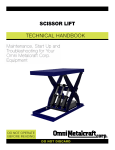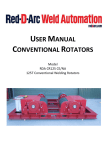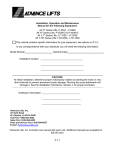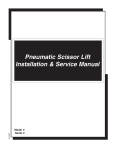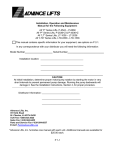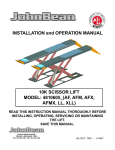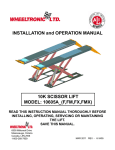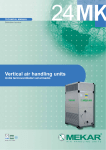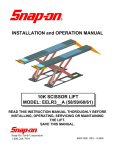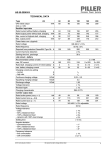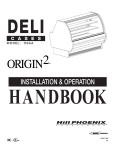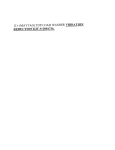Download AIR TABLES MODELS, AT, ATT, ATR, ATI In any
Transcript
Installation, Operation and Maintenance Manual for the Following Equipment: ALL AIR TABLES MODELS, AT, ATT, ATR, ATI In any correspondence with your distributor you will need the following information: Model Number______________________ Serial Number_____________________________ Installation location: __________________________________ __________________________________ __________________________________ CAUTION: Proper familiarization with this manual is essential for safe operation of the unit. Carefully read the operating and maintenance instructions before operating the lift. Distributor Information: ______________________________ _______________________________ _______________________________ Advance Lifts, Inc. 701 S. Kirk Road St. Charles, IL 60174-3428 Toll Free 1-800-843-3625 Sales Fax 1-630-584-9405 Parts and Service Fax 1-630-584-6837 E-mail: [email protected] *Advance Lifts, Inc. furnishes one manual with each unit. Additional manuals are available for $25.00 each. P 1-1 SECTION 2. INDEX & INTRODUCTION Identification Sheet…………………………………………………………. Index & Introduction………………………………………………………… *Responsibilities Of Owners & Users….………………..……………….. *Installation Instructions……………………………..…………………….. *Operation Instructions……………………………………………………… *Maintenance Instructions……………………………………………….. … *Safety Bar Placement Warning Label Specifications & Locations ………………………………. Pneumatic Details…………………………………………………………….. General pneumatic information Pneumatic schematics Pneumatic component lists Mechanical Details………………………………………………………….. Troubleshooting Hints………………………………………………………. Warranty……………………………………………………………………… Attachments: Parts List…………………………………………………….. Optional Accessory Information (Only included when appropriate)….. Section 1 Section 2 Section 3 Section 4 Section 5 Section 6 Section 7 Section 8 Section 9 Section 10 Section 11 Section 12 Section 13 *Mandatory reading before attempting installation. INTRODUCTION Congratulations, the equipment that you have purchased is of the highest quality available. Your Advance Lift will provide you with many years of trouble free service in return for the minimal maintenance described in this manual. Please be sure that no individual is allowed to operate the lift until they have been fully familiarized with the operating instructions in this manual. Also, insure that at least one person at the lift site is familiar with the maintenance section of this manual and is assigned responsibility for doing the maintenance on a regular basis. Please note that the lift has a metal nameplate attached to it that contains information such as the model number, capacities, and serial number. Do not remove the nameplate. Be sure that no operator ever exceeds the capacities shown on the nameplate or they may injure personnel or cause damage to the lift. Also, be sure to have the serial number of the lift handy if you have to call your distributor. That number identifies your specific lift and will allow your distributors personnel to give you the most thorough and timely assistance possible. This manual is under constant review and we would appreciate any constructive suggestions that may enhance its usefulness. Please send your suggestions to Advance lifts, Inc. Attn: Customer Service Department. Thank you for purchasing our product. P 2-1 SECTION 3. RESPONSIBILITIES OF OWNERS & USERS Inspection and Maintenance: The lift shall be inspected and maintained in proper working order in accordance with this manual and safe operating practices. Removal from Service: Any lift not in safe operating condition shall be removed from service until it is repaired to the original manufacturer’s standards. Repairs: Authorized personnel in conformance with the manufacturer’s instructions shall make all repairs. Operators: Only trained and authorized personnel shall be permitted to operate the lift. They must understand to be alert to safety hazards during all operations. Before Operation: Before using the lift, the operator shall have: 1. Read and understood the manufacturer’s operating instructions and safety rules, or been trained by a qualified person. 2. Inspected the lift for proper operation and condition. Any suspect item shall be carefully examined and a determination made by a qualified person as to whether it constitutes a safety hazard. All unsafe items shall be corrected before further use of the lift. During Operations: The lift shall be used only in accordance with its intended use and within the manufacturer’s limitations and safety rules: 1. Do not overload the lift. 2. Insure that all safety devices are operational and in place. 3. Insure that all personnel near the operating lift understand to stand back so that no body parts can be pinched by the mechanism or platform and any items that may fall off the lift will not strike them. Modifications Or Alterations: Modifications or alteration of industrial scissors lifts shall be made in conformance with all applicable provisions of scissors lift manufacturer’s proposed ANSI standards and shall be at least as safe as the equipment was before modification. These changes shall also satisfy recommendations of the original equipment manufacturer for the particular application of the lift. P 3-1 SECTION 4. INSTALLATION INSTRUCTIONS Floor mounted units with baseframes, lift & turn, lift & tilt and tilt units: 1. Move the lift to the usage area; insuring the floor is clean and level. If slings are used, encircle the entire lift, not just the platform. Caution! Before securing the unit to the floor, shim or grout the entire baseframe assembly. Continuous baseframe support is essential for proper installation. 2. Connect the air supply line to the control valve. Recommended air pressure is 70 PSI @ 20 SCFM. Maximum air pressure is 100 PSI for lifting rated load. 3. Using the control valve, fully raise the lift and insert the maintenance bars. CAUTION! See page (P 6-3) for complete instructions on using the maintenance bars. 4. Lag the unit in place using ½” x 5”, “Rawl-Studs” or wedge anchors in the holes provided. 5. Clean any debris remaining from installation. Remove maintenance bars and lower the unit. 6. Instruct user(s) in the proper operation of the lift, safety precautions, and equipment capacity. Supply maintenance personnel with this service manual. Pit mounted units: 1. Check all pit dimensions for accuracy. 2. Attach a temporary air line through the pit conduit to the lift. 3. Using slings, encircle the entire lift, not just the platform and lower the lift into the pit, centering it for 1” minimum clearance on all sides to the pit wall. 4. Raise the lift with the control valve and remove the slings. Run the unit up and down several times to insure proper clearances on pit walls. 5. Fully raise the unit and insert maintenance bars, lower unit onto the bars and discharge air until air pressure is relieved from the system. CAUTION! See page (P 6-3) for complete instructions for proper maintenance bar instruction. 6. Level and center the lift by shimming and grouting the entire baseframe, not just the corners. Lag the unit in place using ½” x 5”, “Rawl-Studs” or wedge anchors in the holes provided. Caution! Continuous baseframe support is essential for proper installation 7. Follow the instructions outlined in paragraphs 5 and 6 under “Floor mounted installation”. To complete the installation. P 4-1 SECTION 5. OPERATING INSTRUCTIONS Pneumatic scissors lifts have an excellent safety record overall, but as with all moving equipment, they can be dangerous. Operators must use common sense and take responsibility for the safety of everyone near the lift. They must use the safety devices provided and be careful not to surprise anyone in the area with the movement of the lift. Pre-operational checks: 1. Check all air connections to be sure that they are completed properly and are operational. 2. The air supply shall be regulated at 70 PSI; it shall also be dry. 3. Check for obstructions or debris that may interfere with the safe operations of the lift. 4. Be sure that all personnel in the area are a safe distance away from the lift and aware that you are about to operate it. 5. If there are any optional safety devices such as limit switches, check them for proper operation. Test operate the equipment: 1. Station yourself so that you will always see the equipment when it is in operation. Never operate the equipment blind! 2. Raise the equipment and note that the control is a constant pressure, “dead-man” type. The control knob shall spring to the neutral position when pressure is released, if not, the control shall be rebuilt or replaced. 3. Cycle the equipment several times to be sure that it is operating smoothly with no jerking or sudden movement. If the operation is not smooth after several cycles, contact your maintenance personnel to have the air plumbing checked. Any evidence of binding or scraping in the operation shall cause you to immediately stop using the lift and contact the factory. 4. Check all safety devices for proper operation. 5. If you elect to test load the equipment be sure that you do not exceed the capacities shown on the nameplate. Overloading may cause structural stresses that may not show up for some time, but will diminish the life and capacity of the unit. If you have any questions about testing the unit, call our customer service department at 1-800843-3625. Daily operation: 1. All personnel shall be required to read the entire operating instruction section of this manual prior to operating the lift. 2. Operators must know the capacity of the unit and be aware of any loads that may exceed the capacity. 3. WARNING! Operators must be alert to personnel in the vicinity of the lift. Avoid any surprises to these personnel in regard to movement of or the position of the lift. Never operate unit if you cannot see it and the personnel around it. P 5-1 SECTION 5. (CONTINUED) OPERATING INSTRUCTIONS Daily operation (continued): 4. On the first use of the lift each day, the operator shall check to see that the lift is functioning properly and smoothly. All safety devices shall be in place and operating correctly. 5. If the unit has a traveling air line, the operator must insure that it is kept away from the lift as it raises and lowers. 6. The center of the load shall be centered on the platform before raising or lowering the lift as this will help insure even wear on all moving parts General Compressed Air Information Notes: 1. PSI and SCFM will affect the speed and capacity of an air spring actuated lift. An increase in PSI will increase the capacity of the lift, as a drop in PSI will reduce the lift capacity. 2. SCFM and load weight will primarily affect the speed in which the table rises. While load weight will have the greatest effect on the lowering speed. 3. Advance Lifts air spring lifts are designed to operate at 70 PSI. SECTION 6. MAINTENANCE INSTRUCTIONS 1. Always remember that machinery with large moving parts can seriously injure you. 2. Read and understand this manual before attempting any service work. 3. WARNING! Always use the safety bars or safety leg when working on the unit in the elevated position or reaching under the platform. (See photos 6-1 and 6-2, at the end of this section for proper positioning and engagement of the safety bars). 4. When using the safety bars, adhere to the following rules: A. The unit must be unloaded. B. Be sure the safety bars are properly engaged. C. Hold the down pedal or pushbutton an extra 10 seconds when lowering onto the safety bars to be sure that all the weight of the lift is on the bars. D. Disconnect and tag the electricity to the unit to prevent accidental movement of the lift by other personnel. E. Spend as little time as possible under the lift. 5. Only use replacement parts recommended by the manufacturer. 6. Do not let the equipment stay in disrepair, fix small problems before they become big problems. A unit in disrepair can become a severe hazard if left unattended. 7. Inspect the equipment on a regular schedule, preferably monthly. P 6-1 SECTION 6. (CONTINUED) MAINTENANCE INSTRUCTIONS 8. Never work on the pneumatic systems unless the unit is fully lowered or properly sitting on the safety support or wheel block. 9. Never apply a load to the equipment until the baseframe is continuously supported. 10. WARNING! Never expect to hold the leg assemblies open by simply lifting one end of a platform. A. The roller end of most lifts is not “gibbed” or captured in any way, so lifting on the roller end will simply tilt the platform. B. Even if you raise the clevis end of the platform, if the base frame is not firmly lagged to the ground or held down by some other means, the legs will come up with the platform in an unpredictable manner and could cause personal injury. C. The only safe way to hold a lift’s legs open other than the factory designed safety support, is to block between the clevis end of the platform and the baseframe. Routine Maintenance: (All lifts) Weekly: Once a week or after repetitive operation, the unit shall be raise to its full height. The air spring and supply hose shall be examined for signs of wear. Monthly: WARNING! Be sure a maintenance safety leg or safety bars are properly engaged before performing maintenance checks 2 through 6 or reaching beneath a raised lift. (See instructions 3, 4 and 10 above). 1. Clean all debris from the vicinity of floor and pit mounted units in order to avoid interference with the lift mechanism or rollers. 2. Check for presence and proper seating of all snap rings and clips on all axles and rollers. 3. Check rollers, pins and bushings for any signs of wear such as flat spots, missing fasteners, or dislodged bearing material. 4. Check the pneumatic fittings for cracks or leaks. 5. Check hoses for abrasions or other abuse and check for snug connections. 6. Operate the unit and check for any abnormal noise or vibrations. 7. Check all safety devices on the unit such as the condition of the pleated bellows or smooth operation of a limit switch. P 6-2 SECTION 6. (CONTINUED) MAINTENANCE INSTRUCTIONS SAFETY MAINTENANCE BAR INSTRUCTIONS WARNING! Always use the safety bars for any service or maintenance. Never go or reach under the lift unless both safety bars are securely in place and the power to the unit has been disconnected to prevent others from operating the lift. Never use the safety bars with a load on the platform. CAUTION! Never use the lift unless the safety bars are properly stored or damage may occur to the equipment. 1. Remove the safety bars from their storage positions by loosening the wing bolts. 2. Raise the lift to full travel, and place a safety bar in front of each roller wheel on the scissors leg. Make sure the safety bar angle captures the baseframe angle (see photos numbered 6-1 and 6-2). Caution! Do not tighten the wing bolt. 3. Once both safety bars are in place, slowly lower the lift until the roller wheel is engaged with the safety bars and the safety bars rest against the end of the baseframe. Visually inspect both safety bars to insure they are secure. 4. To disengage the safety bars raise the lift to move the roller wheels off the safety bars and make sure lift operates correctly. If assistance is required in removal of the safety bar, lightly tap with a hammer to brake it loose. Store the safety bars in their original position and tighten the wing bolt. Store the safety maintenance bar in position shown below. Failure to do so would allow the moving leg to impact the maintenance bar when the list is fully lowered. (See the photographs, 6-1 and 6-2). Maintenance Bar in use (Photo 6-1) Maintenance Bars in Stored Position (Photo 6-2) P 6-3 SECTION 7. WARNING LABEL SPECIFICATIONS & LOCATIONS WARNING LABEL LOCATIONS & SPECIFICATIONS The warning and informational labels normally attached to P Series, LT and LTD lifts, are shown below and their proper mounting locations are shown on page 7-2. Descriptions of the labels are as follows: Label 1: This is simply a promotional label identifying the unit as Advance Lifts unit. Label 2: This is the formal nameplate and it shall never be removed from the unit. The serial number on this nameplate is critical in identifying the specific unit for correct parts and service information. This plate also informs all readers of the proper capacity limits of the unit. Label 3: This is an important “Danger” label that warns users of the three greatest hazards. Label 4: This is a “Warning” label to not ride on the unit. Label 5: This is a “Danger” label reinforcing the need to use maintenance safety legs. P 7-1 WARNING LABEL LOCATIONS PLATFORM FORMAL NAMEPLATE (DO NOT REMOVE) LABEL #2 BASEFRAME LABEL #2 PLATFORM LABEL #4 LABEL #5 BASEFRAME P 7-2 SECTION 8. PNEUMATIC DETAILS FROM COMPRESSOR FLOW VALVE BLEED VALVE SUPPLY AIR (TO LIFT) SUPPLY AIR (TO LIFT) AIR EXHAUST FROM COMPRESSOR TYPICAL AIR CONTROLLERS The hand valve (left) is a typical two-position air valve. Constant pressure must be applied to the control knob for the lift to operate. The foot valve (right) is of a similar design and constant pressure on the pedal is required for lift operation. The foot valve is supplied with a protective cover that has been omitted for clarity. P 8-1 SECTION 9. MECHANICAL DETAILS Platform Platform Pins Retaining Clip Inner Leg Wheel Pin Bearing Outer Leg Spacer Wheel Retaining Clip Bearing Baseframe pin Wear Pad Retaining Clip Retaining Clip Wheel Bearing Retaining Clip Spacer Main Axle Pin Bearing Wheel Pin Retaining Clip Baseframe Clevis Air Spring Mounting Plate Baseframe (Drawing for reference only, Air Spring Removed, Not all options shown) P 9-1 SECTION 10. TROUBLESHOOTING HINTS Warning! Only qualified service personnel shall be allowed to perform service work on pneumatic lifts. The service person shall be familiar with this manual before attempting any service on the lift. Warning! No work shall be performed beneath a raised lift platform unless the safety leg or maintenance blocks are installed in accordance with Section 6 of this manual UNIT WILL NOT LIFT 1. Reduce load to rated capacity. 2. A small amount of debris may be stuck in the control valve. Disassemble the air valve and clean. 3. Confirm correct air pressure supply; refer to Section 5 for correct operating pressure. 4. Check air lines for kinks or damage. 5. Inspect lift for physical damages that may be causing binding and restricting travel. UNIT WILL NOT LOWER Danger! If a lift fails to lower when the valve is actuated yet air is being relieved from the valve great caution must be exercised. Air spring tables are slower to react than hydraulic lifts and mechanical binding or debris may be restricting the lifts travel. If the binding or debris is removed before the table is raised, the table may drop suddenly. 1. An object or debris may be blocking the rollers from moving. Caution! Do not attempt to remove an obstruction without first raising the unit to full height and inserting the maintenance blocks, See page 6-3 for instructions. 2. The air control valve may be malfunctioning, raise the unit and install the maintenance blocks, then disassemble and clean the valve components. P 10-1 ADVANCE LIFTS INC. WARRANTY For a period of one year from date of shipment from the Company’s plant, the Company agrees to replace or repair, free of charge, any defective parts, material or workmanship on new equipment. This shall include electrical and hydraulic components. For a period of ten years or 125,000 cycles (whichever occurs first) from date of shipment from Company’s plant, the Company agrees to replace or repair any defective structure. Company authorization must be obtained prior to the commencement of any work. The Company reserves the right of choice between effecting repairs in the field or paying all freight charges and effecting the repairs at the Company’s plant. The Company further reserves the right of final determination in all warranty considerations. Evidence of overloading, abuse or field modification of units without Company approval shall void this warranty. No contingent liabilities will be accepted. Damage incurred in transport is the responsibility of the carrier and is not covered by this warranty. Any damage detected upon receipt of equipment should be immediately reported to the carrier. If you need assistance filing your claim, please contact Advance Lifts. W-04-07 ADVANCE LIFTS “AT” SERIES PARTS LIST ROLLER WHEEL ASSEMBLY ROLLER WHEEL PIN (UPPER) ROLLER WHEEL PIN (LOWER) ROLLER PIN BEARING (ALL) ROLLER WHEEL SPACER (ALL) ROLLER WHEEL RETAINING CLIP ROLLER WHEEL WEAR PAD P-023-878 P-A-10346 P-A-9993 P-000-363 P-001-483 P-001-876 P-A-9555 MAIN AXLE PIN MAIN AXLE RETAINING CLIP MAIN AXLE BEARING P-A-9992 P-001-876 P-000-363 PLATFORM/BASEFRAME PINS PLATFORM/BASEFRAME CLIP P-A-9992 P-001-876 HAND VALVE BLEED VALVE FLOW VALVE AIR SPRING RELIEF VALVE P-001-318 P-001-501 P-001-339 P-001-881 P-001-308 REPLACEMENT SAFETY BAR REPLACEMENT DECAL KIT REPLACEMENT MANUAL P-A-6275 P-004-138 P-004-539 ADVANCE LIFTS “ATT” SERIES PARTS LIST LIFT TABLE ROLLER WHEELS P-006-223 ROLLER WHEEL RETAINING CLIP P-001-876 ROLLER WHEEL SPACER P-001-845 LEG TO PLATFORM PIN P-A-0234 LEG TO BASE FRAME PIN P-A-0235 PIN RETAINING CLIPS P-001-876 TURN TABLE CAM FOLLOWERS P-003-892 CAM FOLLOWER MOUNTING BOLT P-004-067 MOUNTING BOLT LOCK WASHER P-004-066 MOUNTING BOLT NUT P-004-065 FOOT VALVE (AIR) P-001-316 BLEED VALVE P-001-501 FLOW VALVE P-001-339 RELIEF VALVE P-001-308 AIR SPRING P-001-868 ATR'S (AIR POWERED WITH TURN MANUAL) OUTER WHEEL PIN 1" x 1.97" INNER WHEEL PIN 1" x 2.344" BASE/PLAT PIN 1" x 2 1/4" WHEEL ASSEMBLY CAM FOLLOWER (WHEELS) NUT LOCK WASHER BOLT 90 DEGREE DETENT ASSEMBLY P-A-9993 P-A-10346 P-A-9992 P-023-878 P-003-892 P-004-065 P-004-066 P-004-067 P-004-069 AIR BAG 2 HOLE AIR BAG 4 HOLEHAND VALVE ASSEMBLY FOOT VALVE ASSEMBLY P-001-881 P-001-868 P-004-540 P-004-535 ATI'S (AIR OPERATED TILTER) PLATFORM TO BASE PIN SHOCK ABSORBERS SHOCK ABSORBER KIT P-A-0234 P-027-912 P-027-905 052406

















